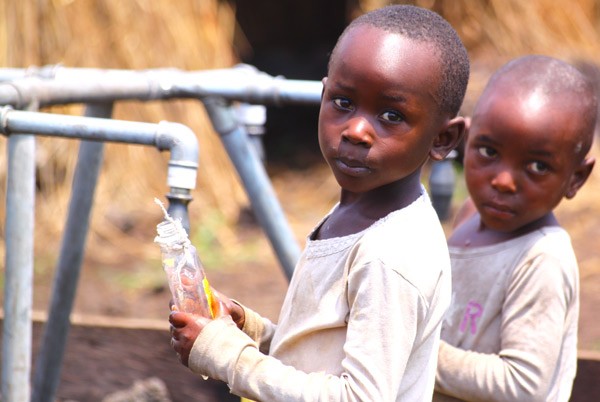
Building a More Secure Society in the Democratic Republic of Congo
Faida Landry, a widowed goat breeder who lives with her five children in the rural village of Makunga in the Democratic Republic of Congo (DRC), was already struggling to feed her family before the conflict came to her doorstep. But after armed gangs ravaged her village making her one of millions of victims of the bloodiest conflict since World War II, she was not sure if her family would make it. “The armed people destroyed all of our family goods, including the goats, and my family suffered as a result,” she said.
Fortunately, Faida and other victims of the violence in the DRC have received food, shelter, healthcare, and water, sanitation, and hygiene (WASH) assistance through a wide-ranging $139.5 million relief effort administered by USAID’s Office of Food for Peace (USAID/FFP) and Office of U.S. Foreign Disaster Assistance (USAID/OFDA) and the U.S. Department of State.
Years of conflict have worsened an already dire humanitarian situation in the chronically poor and underdeveloped country, stealing millions of lives, compromising essential infrastructure, and hindering development efforts. The most recent stage of the conflict started after the implementation of a peace treaty in 2003, when fighting broke out between forces loyal to the Kinshasa government and various armed groups in eastern DRC. In the last decade, the situation has deteriorated, leaving approximately 2.6 million people displaced from their homes.
Recent violence has led to dramatic growth in the number of internally displaced people (IDPs)–there were over 174,000 new IDPs between April and May 2013 alone–making administering aid difficult. “The biggest challenge is that people are being displaced–sometimes multiple times–and in some cases with no stable location to resettle because the conflict moves constantly,” explained Jessica Hartl, a USAID/FFP information officer.
Safe Water, Safe Lives
To reach as many of these vulnerable people as possible, USAID has been providing aid in IDP camps, temporary shelters that can each house up to tens of thousands of people displaced by the ongoing violence.
But even once they reach the relative safety of the camps, IDPs face a different but equally deadly threat: Unhealthy living conditions as a result of inadequate access to WASH. “Displacement due to ongoing conflict between the government and a myriad of armed groups has exacerbated WASH needs among many Congolese,” said James Mosher, disaster operations specialist for USAID/OFDA. “Spontaneous displacement sites throughout the east often lack the water and sanitation facilities required by IDPs.”
Indeed, the majority of people in some IDP hubs, such as the city of Goma, lack access to safe drinking water. Consequently, many IDPs walk up to three hours through insecure areas to search for clean water. In Goma, vulnerable populations often resorted to consuming untreated water directly from Lake Kivu, increasing the risk of cholera and other waterborne diseases. Diarrheal disease is the single most common cause of death in the Democratic Republic of Congo and in the first half of 2013 alone, Congolese health facilities reported over 17,400 cases of cholera. As of May 2013, the U.N. estimates that nearly 21 million people in DRC are in need of WASH assistance due to the complex emergency.
USAID is therefore focusing on improving WASH, especially in IDP camps in Goma and other areas. They are working with implementing partners to upgrade key water supply infrastructure, install water chlorination points, and build latrines. In addition, they empower the Congolese to take control over their health by facilitating the formation of health and water committees and by conducting trainings on sanitation and hygiene while distributing hygiene supplies like soap. These trainings can make the difference between life and death in the camps, where people live in extremely close quarters. USAID hopes to reach over 1 million people with these efforts.
Fostering a Food-Secure and Self-Sufficient Future
While the conflict continues, USAID is also looking outside the camps to foster long-term stability, self-sufficiency, and food security. Whenever possible, USAID buys food from local farmers to distribute in the camps, which provides a market for food from smallholder farmers. USAID supports other farmers by providing agriculture productivity training, distributing key farming materials, and paying local Congolese with food to repair damaged irrigation infrastructure. “We are not just trying to save lives, we’re also trying to help foster a more secure, sustainable society,” said Ms. Hartl.
For conflict victims like Faida, these efforts not only boost health, food security, and livelihoods–but also hope. Faida reported that, after days and days of feeling hopeless, “Today I am dreaming of a good future for my family.”
C. Zeilberger







Comment
Make a general inquiry or suggest an improvement.